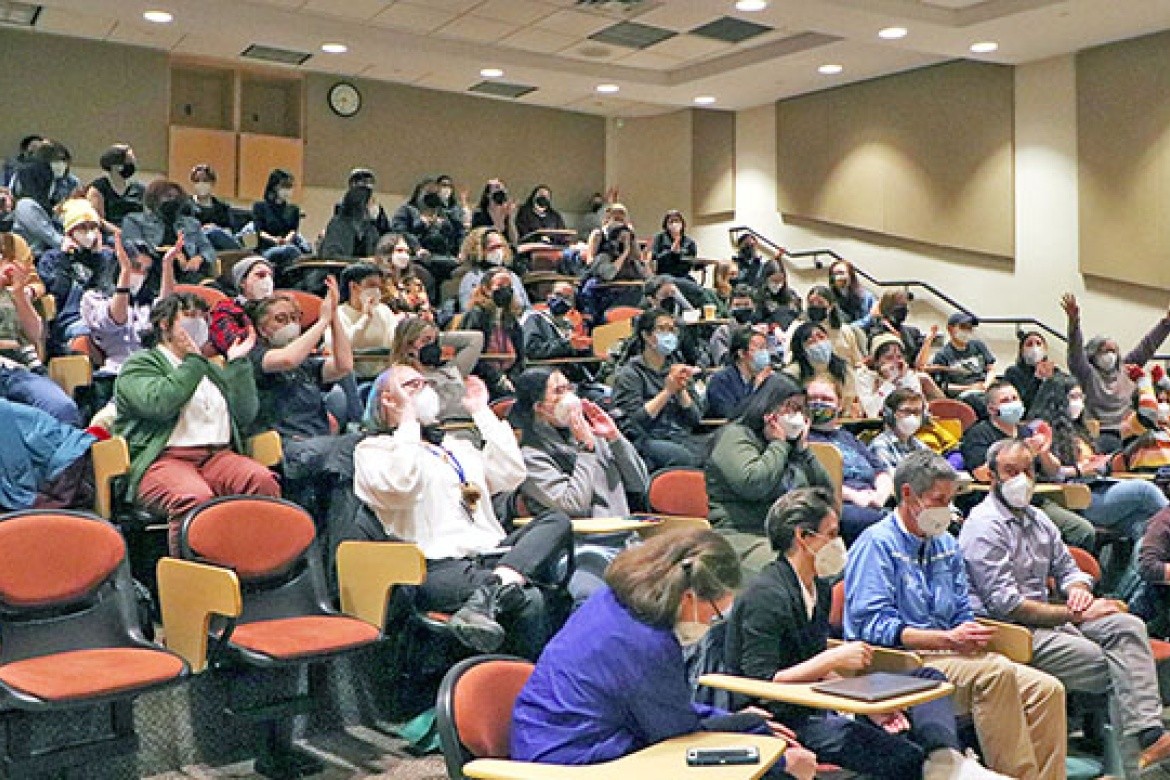In the nosh pit

The annual Latke-Hamantaschen Debate is Mount Holyoke College’s most cerebral food fight.
When Rachel Corbman, visiting lecturer in gender studies, received an invitation to participate in Mount Holyoke’s annual Latke-Hamantaschen Debate, it was an easy “yes.” However, Corbman had one stipulation: She wanted to be on Team Hamantaschen. “They’re a conceptually interesting food, versus latkes, which are just kind of yummy,” she explains.
But that choice set Corbman up as the underdog. “Team Latke almost always wins,” says Emma Mair ’23, from Middleton, Massachusetts. Mair, as one of the Jewish Student Union’s co-chairs, helped with organizing this year’s event. She adds, “I think people just like salty things more.”
But really, are there any losers when a campus gathers to celebrate Jewish culture and gobble handmade pastries?
On March 9, 2022, faculty, students and administrators gathered in Cleveland Hall for the 17th annual Latke-Hamantaschen Debate. While the event is a relatively new tradition at Mount Holyoke, its history in the Jewish community stretches back generations. According to a 2005 story in the University of Chicago Magazine, the first latke-hamantaschen face-off happened in 1945 at the University of Chicago. At that time, academia discouraged professors from sharing their Jewish identities. The debate, which featured arguments both farcical and fantastical, was always meant to be a dig at the academic establishment. Just as important, though, it brought Jewish culture front and center at the University of Chicago. That mission remains in place today at schools across the country.
“I love the opportunity the event presents to bring people in to learn about Judaism,” said Mair. Each year the debate happens close to Purim, a festival celebrating the triumph of the Jewish over Haman, a leader who ordered their mass execution. Members of the Jewish Student Union make dozens of hamantaschen in the kosher kitchen at Eliot House to share with all attendees. “Food is something that is accessible to everyone,” which is part of what makes this event so approachable, says Giovanna Wiseman ’22, from Sharon, Massachusetts, who co-chairs the Jewish Student Union.
Mair pointed out that both latkes and hamantaschen are Ashkenazi traditions, meaning they are made mostly in families whose roots trace back to Central and Eastern Europe. “We’ve been working very hard to move our framework away from an Ashkenazi normative practice,” she said, adding that celebrating Judaism’s diversity is an important mission for the Jewish Student Union.
The Latke-Hamantaschen Debate won’t, however, change any time soon. It’s a beloved tradition. Instead, they’re “hoping to pick up the slack by supplementing other traditions, like with a bourekas-making workshop, which is a Sephardic tradition,” Mair said. She added, “if we can’t represent all the diversity of the Jewish community in this event, we really want to make sure that we’re looking to do it in other ways throughout the year.”
This year the debate happened a week before the beginning of Purim. That timing is not an accident. “Purim is sort of a holiday of fun and lightheartedness,” said Wiseman. Wiseman added that she loves how this event showcases a proud Jewish tradition: the culture of dialogue and debate.
There was no shortage of viewpoints on stage at the 2022 Latke-Hamantaschen Debate. Academia, after all, is not known for being light on opinions. Each year the Jewish Student Union sends invitations to particularly lively faculty and staff members, said Mair. It doesn’t matter if participants are Jewish. All that matters is that they’re up for some intellectual sparring — and are not afraid to embrace the absurd in pursuit of a win.
Over the past decade and a half, arguments have ranged from latkes trigger a neurochemical response better than sex to hamantaschen’s triangular shape echos Chinese characters that mean “humankind is one.” That argument concluded that if anything could broker world peace, surely it would be flaky pastry wrapped around sweet fillings. Often, debaters draw on their personal academic fields; however, it’s not a requirement, said Wiseman.
The moment Corbman accepted her slot on Team Hamantaschen, she knew she wanted to use her research to prove its superior snack status. Corbman is a public historian specializing in the history of queer theory. She knew she could connect hamantaschen — and their symbolism in Jewish culture — to queer theory. Step one was venturing down a deep rabbit hole of videos from previous debates to gather ideas and seeing just how far other debaters took their arguments. Step two was reflecting on the fact that two early queer theorists, Eve Sedgwick and Judith Butler, were both Jewish. “I was actually once asked at an academic conference, when I was presenting a paper on Judith Butler and Eve Sedgwick, how Jewish cultural traditions and Jewish theology played a role in their thinking,” she said. She admitted that at the time she “had no idea what to say.” Now, with the debate looming large, it was time to give this question serious thought.
While Eve Sedgwick passed away in 2009, Corbman knew that the easiest way to find out where Judith Butler stood on the fried-versus-baked question was simply to ask. Corbman fired off an email, closing with, “My apologies if this is answered in your published work.” Butler didn’t hesitate to weigh in. “She got back to me in 17 minutes,” said Corbman. Unfortunately for Corbman, Butler declared her allegiance to Team Latke.
Corbman still stands proudly behind Team Hamantaschen, though. “Hamantaschen are based on the hat of the antagonist in the Purim story,” she explains. Latkes may celebrate a miracle, but hamantaschen celebrate taking a bite out of your oppressor’s power.
The judges this year agreed. Victory in 2022 was sweet, with Hamantaschen coming out on top.
